Leadership and Management: Roles, Theories, and Tesco's Application
VerifiedAdded on 2020/10/23
|19
|5109
|457
Report
AI Summary
This report examines leadership and management practices within Tesco, a leading UK retail company. It begins by defining and comparing the roles and characteristics of leaders and managers, highlighting their distinct approaches to organizational objectives. The report then analyzes how leadership and management functions apply to various situational contexts, including technological changes, labor turnover, and conflict resolution, providing specific examples of Tesco's strategies. Furthermore, it explores the application of different leadership theories and models, such as situational leadership, systems leadership, and contingency theory, assessing their relevance and effectiveness within the Tesco context. The report also covers key approaches to operations management, its value, and the impact of internal factors on the business environment. Through this comprehensive analysis, the report offers insights into how Tesco navigates challenges and achieves its goals through effective leadership and management practices.
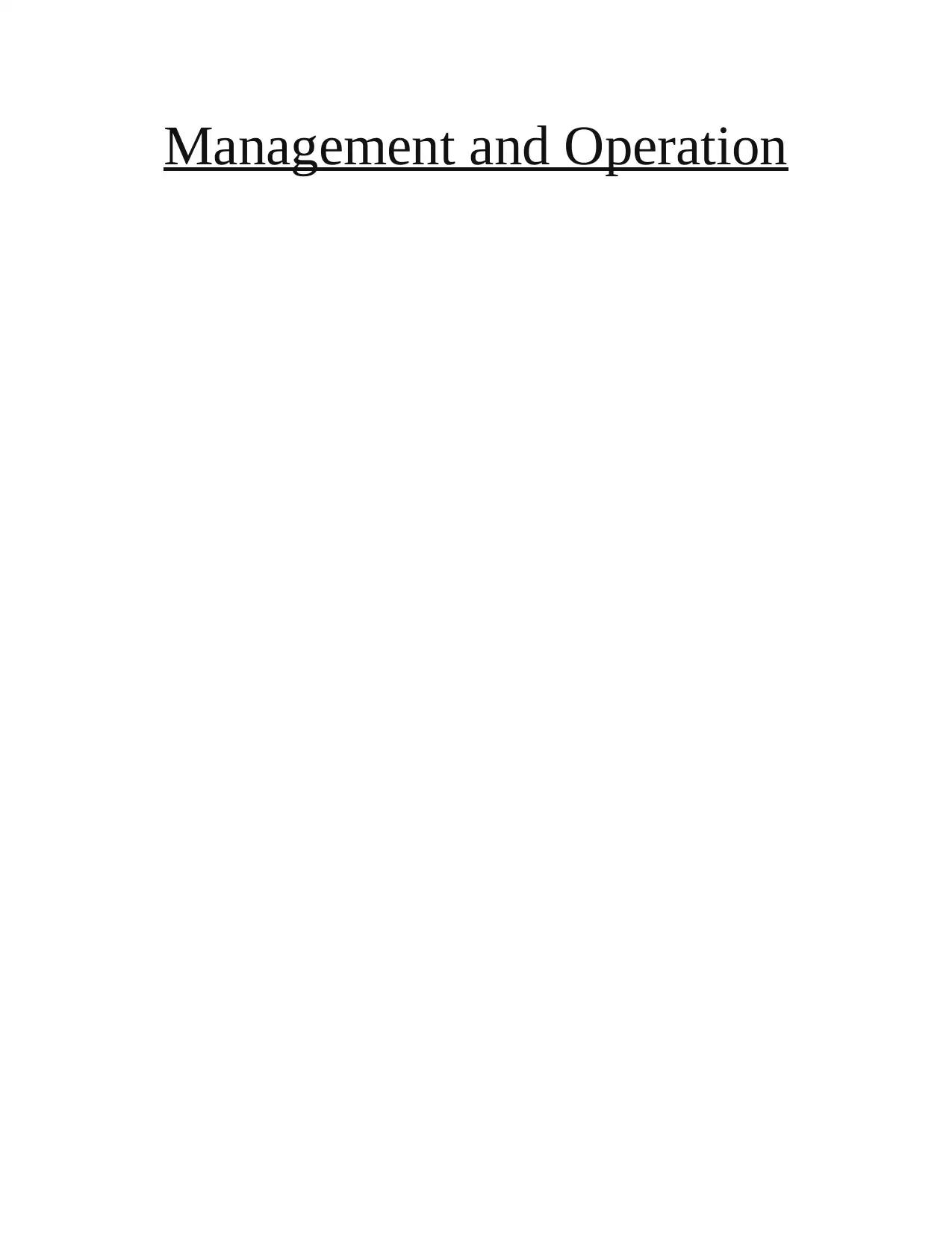
Management and Operation
Paraphrase This Document
Need a fresh take? Get an instant paraphrase of this document with our AI Paraphraser
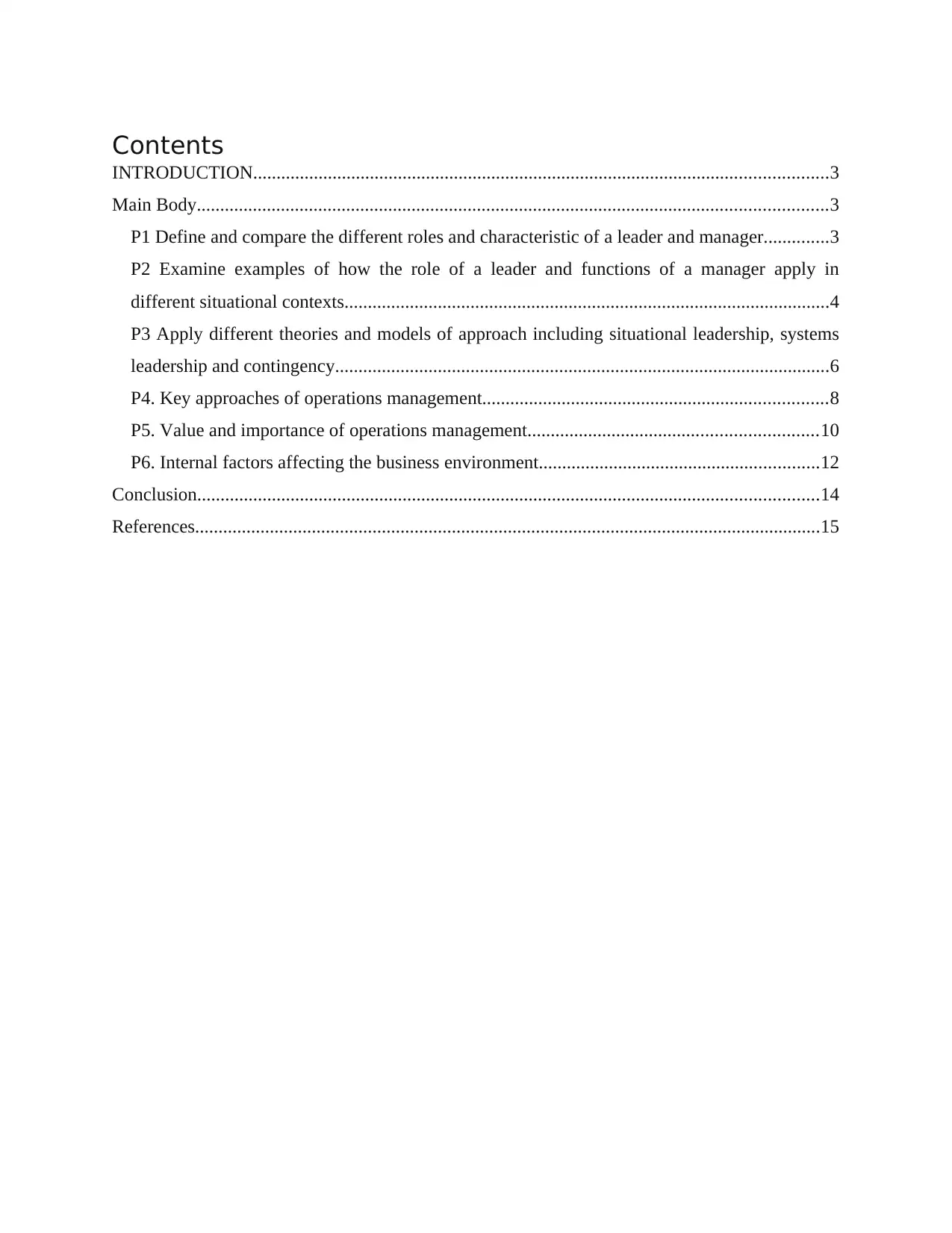
Contents
INTRODUCTION...........................................................................................................................3
Main Body.......................................................................................................................................3
P1 Define and compare the different roles and characteristic of a leader and manager..............3
P2 Examine examples of how the role of a leader and functions of a manager apply in
different situational contexts........................................................................................................4
P3 Apply different theories and models of approach including situational leadership, systems
leadership and contingency..........................................................................................................6
P4. Key approaches of operations management..........................................................................8
P5. Value and importance of operations management..............................................................10
P6. Internal factors affecting the business environment............................................................12
Conclusion.....................................................................................................................................14
References......................................................................................................................................15
INTRODUCTION...........................................................................................................................3
Main Body.......................................................................................................................................3
P1 Define and compare the different roles and characteristic of a leader and manager..............3
P2 Examine examples of how the role of a leader and functions of a manager apply in
different situational contexts........................................................................................................4
P3 Apply different theories and models of approach including situational leadership, systems
leadership and contingency..........................................................................................................6
P4. Key approaches of operations management..........................................................................8
P5. Value and importance of operations management..............................................................10
P6. Internal factors affecting the business environment............................................................12
Conclusion.....................................................................................................................................14
References......................................................................................................................................15
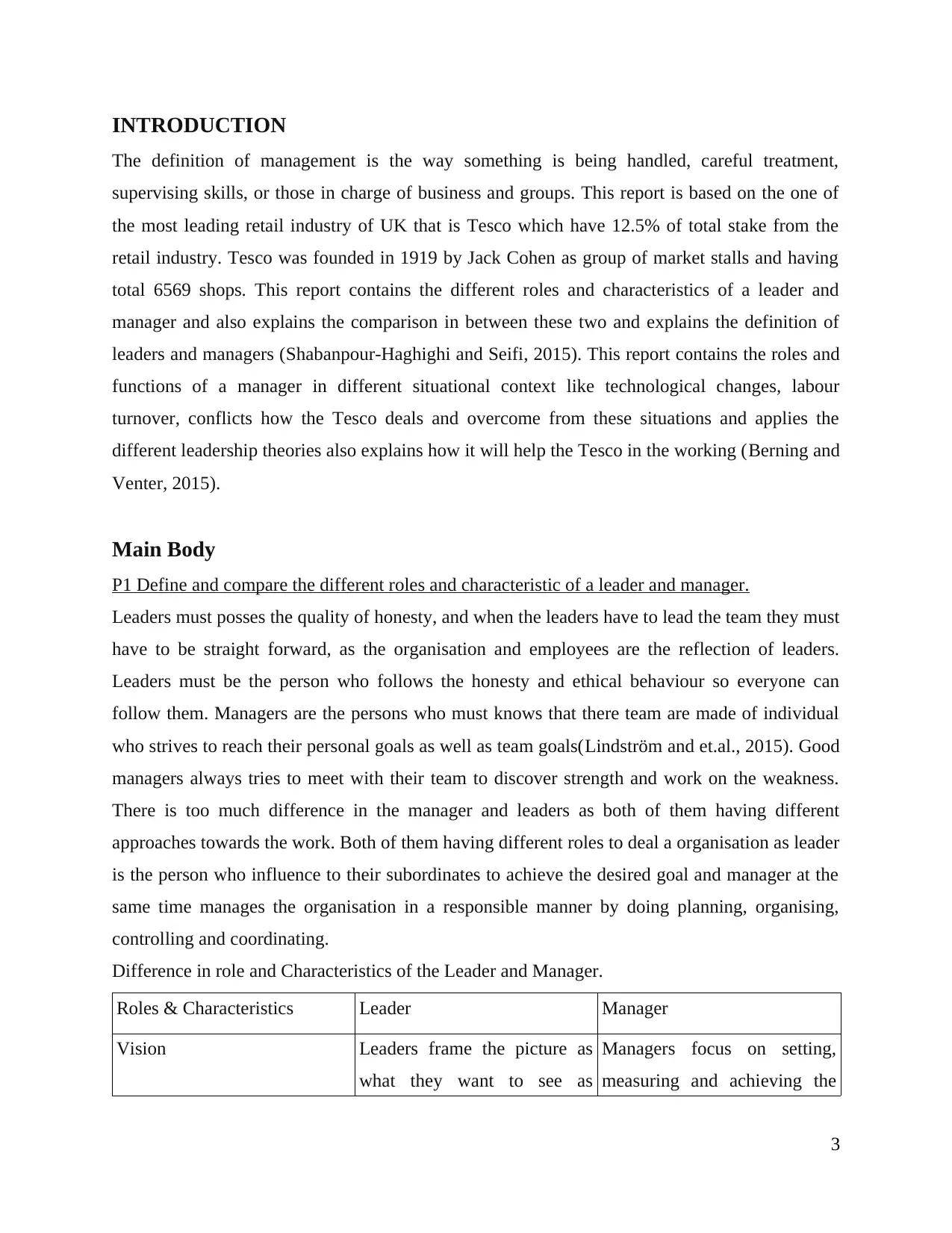
INTRODUCTION
The definition of management is the way something is being handled, careful treatment,
supervising skills, or those in charge of business and groups. This report is based on the one of
the most leading retail industry of UK that is Tesco which have 12.5% of total stake from the
retail industry. Tesco was founded in 1919 by Jack Cohen as group of market stalls and having
total 6569 shops. This report contains the different roles and characteristics of a leader and
manager and also explains the comparison in between these two and explains the definition of
leaders and managers (Shabanpour-Haghighi and Seifi, 2015). This report contains the roles and
functions of a manager in different situational context like technological changes, labour
turnover, conflicts how the Tesco deals and overcome from these situations and applies the
different leadership theories also explains how it will help the Tesco in the working (Berning and
Venter, 2015).
Main Body
P1 Define and compare the different roles and characteristic of a leader and manager.
Leaders must posses the quality of honesty, and when the leaders have to lead the team they must
have to be straight forward, as the organisation and employees are the reflection of leaders.
Leaders must be the person who follows the honesty and ethical behaviour so everyone can
follow them. Managers are the persons who must knows that there team are made of individual
who strives to reach their personal goals as well as team goals(Lindström and et.al., 2015). Good
managers always tries to meet with their team to discover strength and work on the weakness.
There is too much difference in the manager and leaders as both of them having different
approaches towards the work. Both of them having different roles to deal a organisation as leader
is the person who influence to their subordinates to achieve the desired goal and manager at the
same time manages the organisation in a responsible manner by doing planning, organising,
controlling and coordinating.
Difference in role and Characteristics of the Leader and Manager.
Roles & Characteristics Leader Manager
Vision Leaders frame the picture as
what they want to see as
Managers focus on setting,
measuring and achieving the
3
The definition of management is the way something is being handled, careful treatment,
supervising skills, or those in charge of business and groups. This report is based on the one of
the most leading retail industry of UK that is Tesco which have 12.5% of total stake from the
retail industry. Tesco was founded in 1919 by Jack Cohen as group of market stalls and having
total 6569 shops. This report contains the different roles and characteristics of a leader and
manager and also explains the comparison in between these two and explains the definition of
leaders and managers (Shabanpour-Haghighi and Seifi, 2015). This report contains the roles and
functions of a manager in different situational context like technological changes, labour
turnover, conflicts how the Tesco deals and overcome from these situations and applies the
different leadership theories also explains how it will help the Tesco in the working (Berning and
Venter, 2015).
Main Body
P1 Define and compare the different roles and characteristic of a leader and manager.
Leaders must posses the quality of honesty, and when the leaders have to lead the team they must
have to be straight forward, as the organisation and employees are the reflection of leaders.
Leaders must be the person who follows the honesty and ethical behaviour so everyone can
follow them. Managers are the persons who must knows that there team are made of individual
who strives to reach their personal goals as well as team goals(Lindström and et.al., 2015). Good
managers always tries to meet with their team to discover strength and work on the weakness.
There is too much difference in the manager and leaders as both of them having different
approaches towards the work. Both of them having different roles to deal a organisation as leader
is the person who influence to their subordinates to achieve the desired goal and manager at the
same time manages the organisation in a responsible manner by doing planning, organising,
controlling and coordinating.
Difference in role and Characteristics of the Leader and Manager.
Roles & Characteristics Leader Manager
Vision Leaders frame the picture as
what they want to see as
Managers focus on setting,
measuring and achieving the
3
⊘ This is a preview!⊘
Do you want full access?
Subscribe today to unlock all pages.

Trusted by 1+ million students worldwide
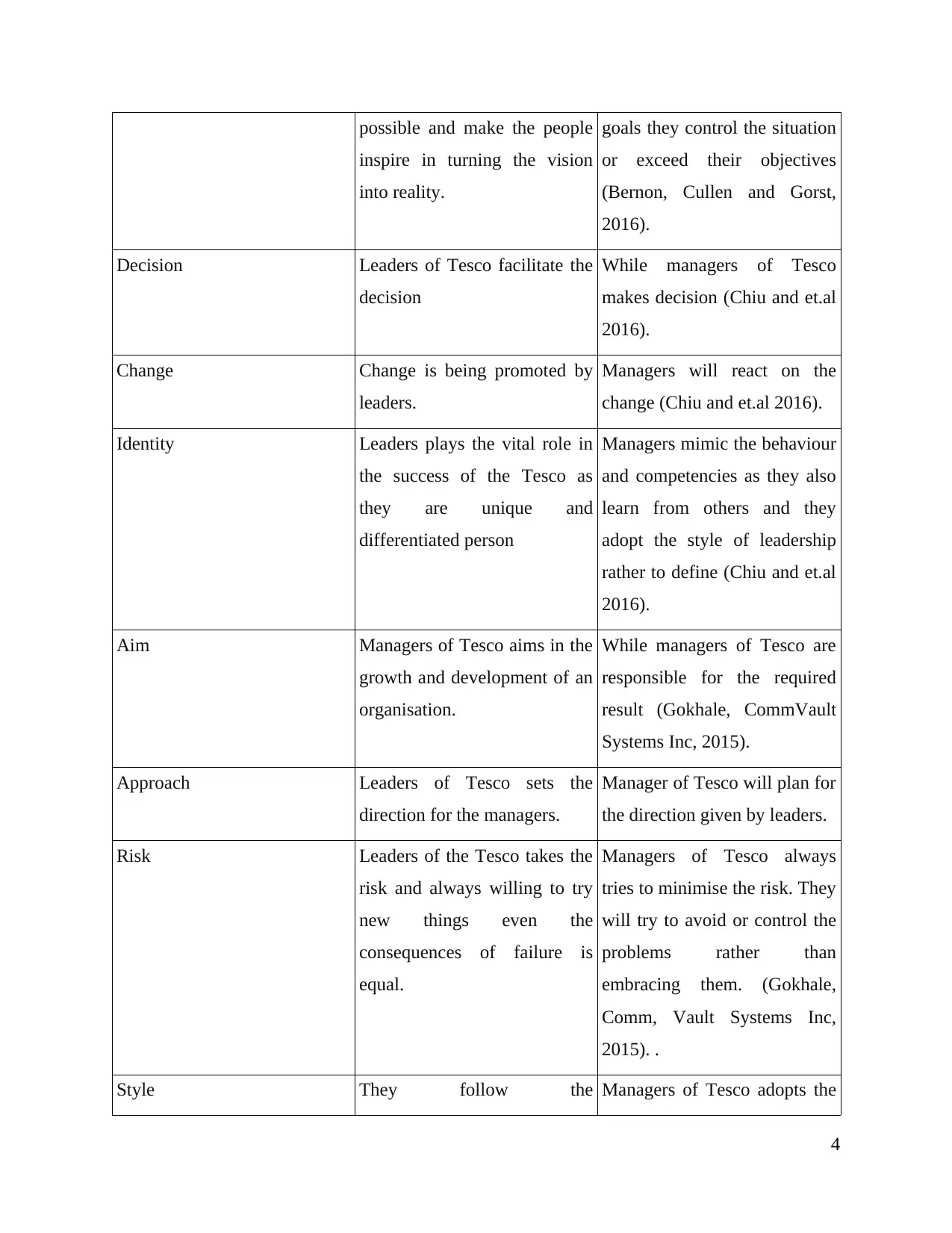
possible and make the people
inspire in turning the vision
into reality.
goals they control the situation
or exceed their objectives
(Bernon, Cullen and Gorst,
2016).
Decision Leaders of Tesco facilitate the
decision
While managers of Tesco
makes decision (Chiu and et.al
2016).
Change Change is being promoted by
leaders.
Managers will react on the
change (Chiu and et.al 2016).
Identity Leaders plays the vital role in
the success of the Tesco as
they are unique and
differentiated person
Managers mimic the behaviour
and competencies as they also
learn from others and they
adopt the style of leadership
rather to define (Chiu and et.al
2016).
Aim Managers of Tesco aims in the
growth and development of an
organisation.
While managers of Tesco are
responsible for the required
result (Gokhale, CommVault
Systems Inc, 2015).
Approach Leaders of Tesco sets the
direction for the managers.
Manager of Tesco will plan for
the direction given by leaders.
Risk Leaders of the Tesco takes the
risk and always willing to try
new things even the
consequences of failure is
equal.
Managers of Tesco always
tries to minimise the risk. They
will try to avoid or control the
problems rather than
embracing them. (Gokhale,
Comm, Vault Systems Inc,
2015). .
Style They follow the Managers of Tesco adopts the
4
inspire in turning the vision
into reality.
goals they control the situation
or exceed their objectives
(Bernon, Cullen and Gorst,
2016).
Decision Leaders of Tesco facilitate the
decision
While managers of Tesco
makes decision (Chiu and et.al
2016).
Change Change is being promoted by
leaders.
Managers will react on the
change (Chiu and et.al 2016).
Identity Leaders plays the vital role in
the success of the Tesco as
they are unique and
differentiated person
Managers mimic the behaviour
and competencies as they also
learn from others and they
adopt the style of leadership
rather to define (Chiu and et.al
2016).
Aim Managers of Tesco aims in the
growth and development of an
organisation.
While managers of Tesco are
responsible for the required
result (Gokhale, CommVault
Systems Inc, 2015).
Approach Leaders of Tesco sets the
direction for the managers.
Manager of Tesco will plan for
the direction given by leaders.
Risk Leaders of the Tesco takes the
risk and always willing to try
new things even the
consequences of failure is
equal.
Managers of Tesco always
tries to minimise the risk. They
will try to avoid or control the
problems rather than
embracing them. (Gokhale,
Comm, Vault Systems Inc,
2015). .
Style They follow the Managers of Tesco adopts the
4
Paraphrase This Document
Need a fresh take? Get an instant paraphrase of this document with our AI Paraphraser
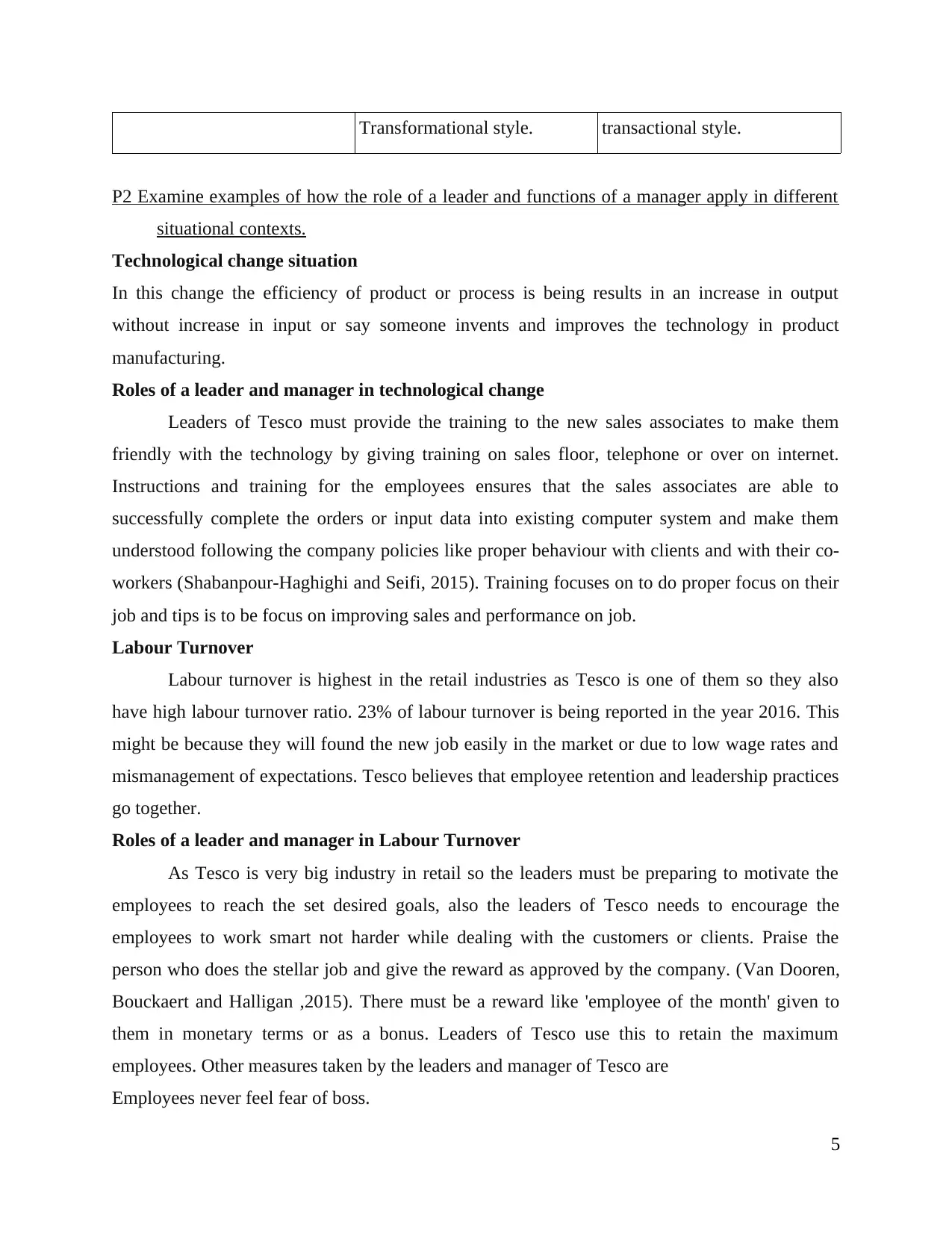
Transformational style. transactional style.
P2 Examine examples of how the role of a leader and functions of a manager apply in different
situational contexts.
Technological change situation
In this change the efficiency of product or process is being results in an increase in output
without increase in input or say someone invents and improves the technology in product
manufacturing.
Roles of a leader and manager in technological change
Leaders of Tesco must provide the training to the new sales associates to make them
friendly with the technology by giving training on sales floor, telephone or over on internet.
Instructions and training for the employees ensures that the sales associates are able to
successfully complete the orders or input data into existing computer system and make them
understood following the company policies like proper behaviour with clients and with their co-
workers (Shabanpour-Haghighi and Seifi, 2015). Training focuses on to do proper focus on their
job and tips is to be focus on improving sales and performance on job.
Labour Turnover
Labour turnover is highest in the retail industries as Tesco is one of them so they also
have high labour turnover ratio. 23% of labour turnover is being reported in the year 2016. This
might be because they will found the new job easily in the market or due to low wage rates and
mismanagement of expectations. Tesco believes that employee retention and leadership practices
go together.
Roles of a leader and manager in Labour Turnover
As Tesco is very big industry in retail so the leaders must be preparing to motivate the
employees to reach the set desired goals, also the leaders of Tesco needs to encourage the
employees to work smart not harder while dealing with the customers or clients. Praise the
person who does the stellar job and give the reward as approved by the company. (Van Dooren,
Bouckaert and Halligan ,2015). There must be a reward like 'employee of the month' given to
them in monetary terms or as a bonus. Leaders of Tesco use this to retain the maximum
employees. Other measures taken by the leaders and manager of Tesco are
Employees never feel fear of boss.
5
P2 Examine examples of how the role of a leader and functions of a manager apply in different
situational contexts.
Technological change situation
In this change the efficiency of product or process is being results in an increase in output
without increase in input or say someone invents and improves the technology in product
manufacturing.
Roles of a leader and manager in technological change
Leaders of Tesco must provide the training to the new sales associates to make them
friendly with the technology by giving training on sales floor, telephone or over on internet.
Instructions and training for the employees ensures that the sales associates are able to
successfully complete the orders or input data into existing computer system and make them
understood following the company policies like proper behaviour with clients and with their co-
workers (Shabanpour-Haghighi and Seifi, 2015). Training focuses on to do proper focus on their
job and tips is to be focus on improving sales and performance on job.
Labour Turnover
Labour turnover is highest in the retail industries as Tesco is one of them so they also
have high labour turnover ratio. 23% of labour turnover is being reported in the year 2016. This
might be because they will found the new job easily in the market or due to low wage rates and
mismanagement of expectations. Tesco believes that employee retention and leadership practices
go together.
Roles of a leader and manager in Labour Turnover
As Tesco is very big industry in retail so the leaders must be preparing to motivate the
employees to reach the set desired goals, also the leaders of Tesco needs to encourage the
employees to work smart not harder while dealing with the customers or clients. Praise the
person who does the stellar job and give the reward as approved by the company. (Van Dooren,
Bouckaert and Halligan ,2015). There must be a reward like 'employee of the month' given to
them in monetary terms or as a bonus. Leaders of Tesco use this to retain the maximum
employees. Other measures taken by the leaders and manager of Tesco are
Employees never feel fear of boss.
5
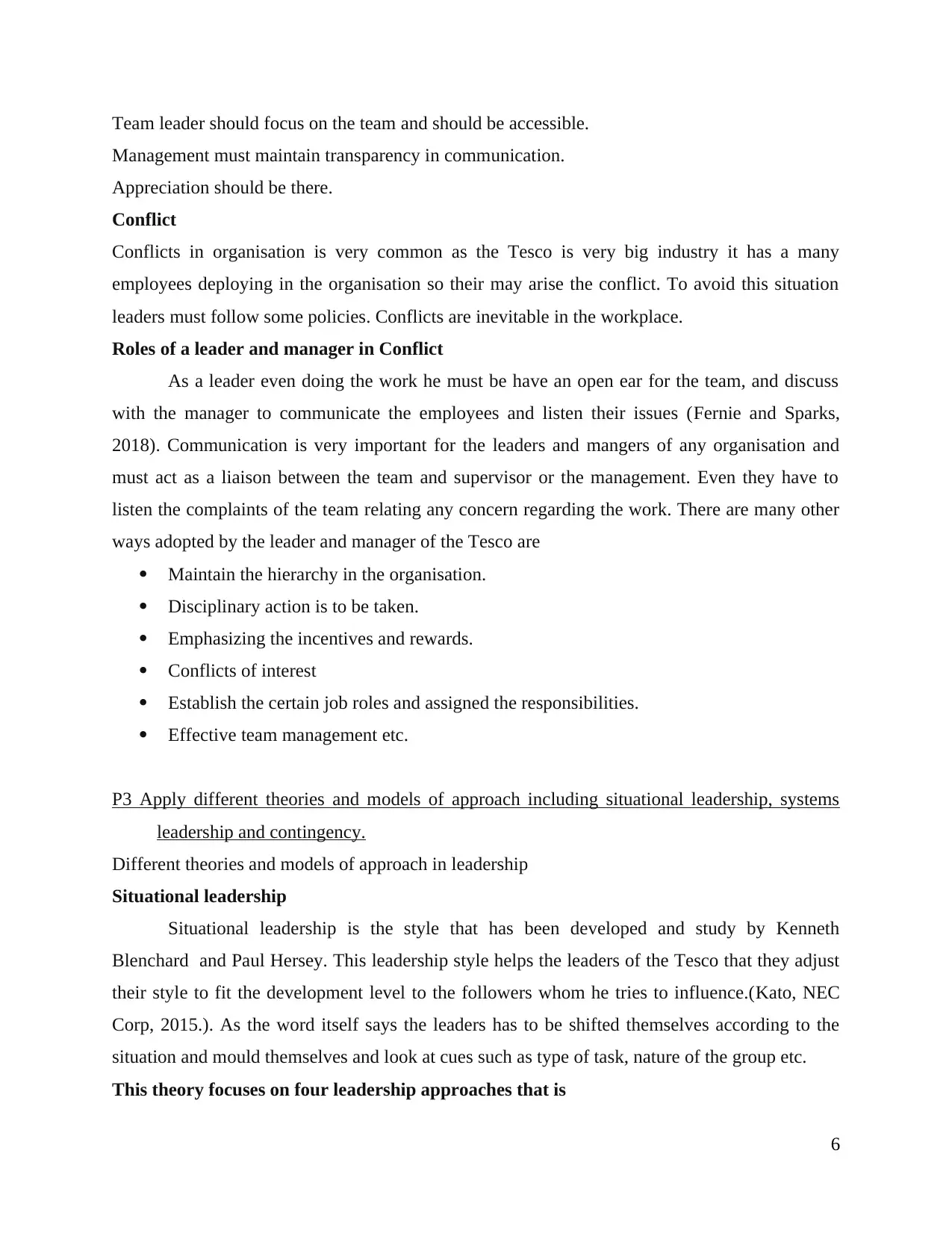
Team leader should focus on the team and should be accessible.
Management must maintain transparency in communication.
Appreciation should be there.
Conflict
Conflicts in organisation is very common as the Tesco is very big industry it has a many
employees deploying in the organisation so their may arise the conflict. To avoid this situation
leaders must follow some policies. Conflicts are inevitable in the workplace.
Roles of a leader and manager in Conflict
As a leader even doing the work he must be have an open ear for the team, and discuss
with the manager to communicate the employees and listen their issues (Fernie and Sparks,
2018). Communication is very important for the leaders and mangers of any organisation and
must act as a liaison between the team and supervisor or the management. Even they have to
listen the complaints of the team relating any concern regarding the work. There are many other
ways adopted by the leader and manager of the Tesco are
Maintain the hierarchy in the organisation.
Disciplinary action is to be taken.
Emphasizing the incentives and rewards.
Conflicts of interest
Establish the certain job roles and assigned the responsibilities.
Effective team management etc.
P3 Apply different theories and models of approach including situational leadership, systems
leadership and contingency.
Different theories and models of approach in leadership
Situational leadership
Situational leadership is the style that has been developed and study by Kenneth
Blenchard and Paul Hersey. This leadership style helps the leaders of the Tesco that they adjust
their style to fit the development level to the followers whom he tries to influence.(Kato, NEC
Corp, 2015.). As the word itself says the leaders has to be shifted themselves according to the
situation and mould themselves and look at cues such as type of task, nature of the group etc.
This theory focuses on four leadership approaches that is
6
Management must maintain transparency in communication.
Appreciation should be there.
Conflict
Conflicts in organisation is very common as the Tesco is very big industry it has a many
employees deploying in the organisation so their may arise the conflict. To avoid this situation
leaders must follow some policies. Conflicts are inevitable in the workplace.
Roles of a leader and manager in Conflict
As a leader even doing the work he must be have an open ear for the team, and discuss
with the manager to communicate the employees and listen their issues (Fernie and Sparks,
2018). Communication is very important for the leaders and mangers of any organisation and
must act as a liaison between the team and supervisor or the management. Even they have to
listen the complaints of the team relating any concern regarding the work. There are many other
ways adopted by the leader and manager of the Tesco are
Maintain the hierarchy in the organisation.
Disciplinary action is to be taken.
Emphasizing the incentives and rewards.
Conflicts of interest
Establish the certain job roles and assigned the responsibilities.
Effective team management etc.
P3 Apply different theories and models of approach including situational leadership, systems
leadership and contingency.
Different theories and models of approach in leadership
Situational leadership
Situational leadership is the style that has been developed and study by Kenneth
Blenchard and Paul Hersey. This leadership style helps the leaders of the Tesco that they adjust
their style to fit the development level to the followers whom he tries to influence.(Kato, NEC
Corp, 2015.). As the word itself says the leaders has to be shifted themselves according to the
situation and mould themselves and look at cues such as type of task, nature of the group etc.
This theory focuses on four leadership approaches that is
6
⊘ This is a preview!⊘
Do you want full access?
Subscribe today to unlock all pages.

Trusted by 1+ million students worldwide
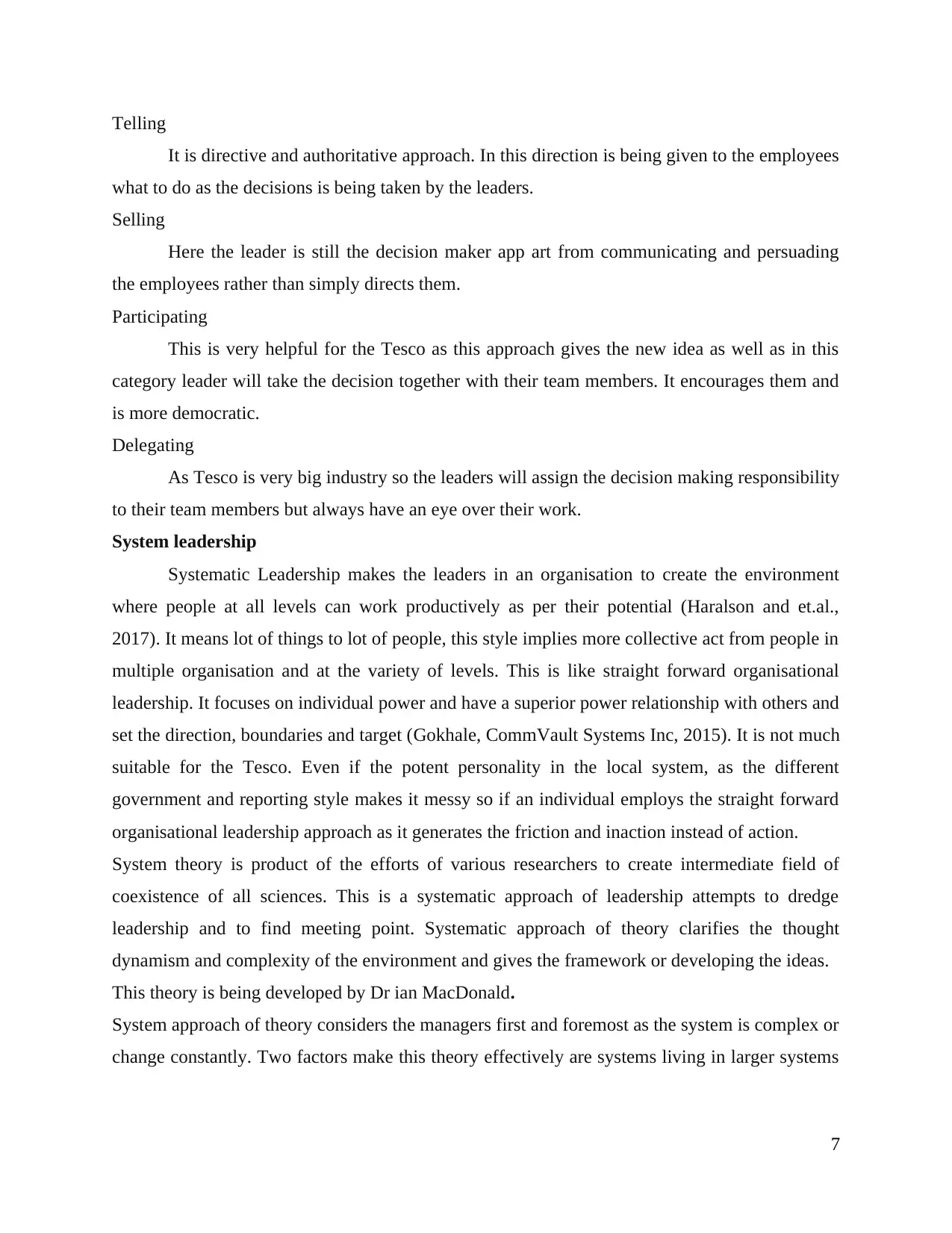
Telling
It is directive and authoritative approach. In this direction is being given to the employees
what to do as the decisions is being taken by the leaders.
Selling
Here the leader is still the decision maker app art from communicating and persuading
the employees rather than simply directs them.
Participating
This is very helpful for the Tesco as this approach gives the new idea as well as in this
category leader will take the decision together with their team members. It encourages them and
is more democratic.
Delegating
As Tesco is very big industry so the leaders will assign the decision making responsibility
to their team members but always have an eye over their work.
System leadership
Systematic Leadership makes the leaders in an organisation to create the environment
where people at all levels can work productively as per their potential (Haralson and et.al.,
2017). It means lot of things to lot of people, this style implies more collective act from people in
multiple organisation and at the variety of levels. This is like straight forward organisational
leadership. It focuses on individual power and have a superior power relationship with others and
set the direction, boundaries and target (Gokhale, CommVault Systems Inc, 2015). It is not much
suitable for the Tesco. Even if the potent personality in the local system, as the different
government and reporting style makes it messy so if an individual employs the straight forward
organisational leadership approach as it generates the friction and inaction instead of action.
System theory is product of the efforts of various researchers to create intermediate field of
coexistence of all sciences. This is a systematic approach of leadership attempts to dredge
leadership and to find meeting point. Systematic approach of theory clarifies the thought
dynamism and complexity of the environment and gives the framework or developing the ideas.
This theory is being developed by Dr ian MacDonald.
System approach of theory considers the managers first and foremost as the system is complex or
change constantly. Two factors make this theory effectively are systems living in larger systems
7
It is directive and authoritative approach. In this direction is being given to the employees
what to do as the decisions is being taken by the leaders.
Selling
Here the leader is still the decision maker app art from communicating and persuading
the employees rather than simply directs them.
Participating
This is very helpful for the Tesco as this approach gives the new idea as well as in this
category leader will take the decision together with their team members. It encourages them and
is more democratic.
Delegating
As Tesco is very big industry so the leaders will assign the decision making responsibility
to their team members but always have an eye over their work.
System leadership
Systematic Leadership makes the leaders in an organisation to create the environment
where people at all levels can work productively as per their potential (Haralson and et.al.,
2017). It means lot of things to lot of people, this style implies more collective act from people in
multiple organisation and at the variety of levels. This is like straight forward organisational
leadership. It focuses on individual power and have a superior power relationship with others and
set the direction, boundaries and target (Gokhale, CommVault Systems Inc, 2015). It is not much
suitable for the Tesco. Even if the potent personality in the local system, as the different
government and reporting style makes it messy so if an individual employs the straight forward
organisational leadership approach as it generates the friction and inaction instead of action.
System theory is product of the efforts of various researchers to create intermediate field of
coexistence of all sciences. This is a systematic approach of leadership attempts to dredge
leadership and to find meeting point. Systematic approach of theory clarifies the thought
dynamism and complexity of the environment and gives the framework or developing the ideas.
This theory is being developed by Dr ian MacDonald.
System approach of theory considers the managers first and foremost as the system is complex or
change constantly. Two factors make this theory effectively are systems living in larger systems
7
Paraphrase This Document
Need a fresh take? Get an instant paraphrase of this document with our AI Paraphraser
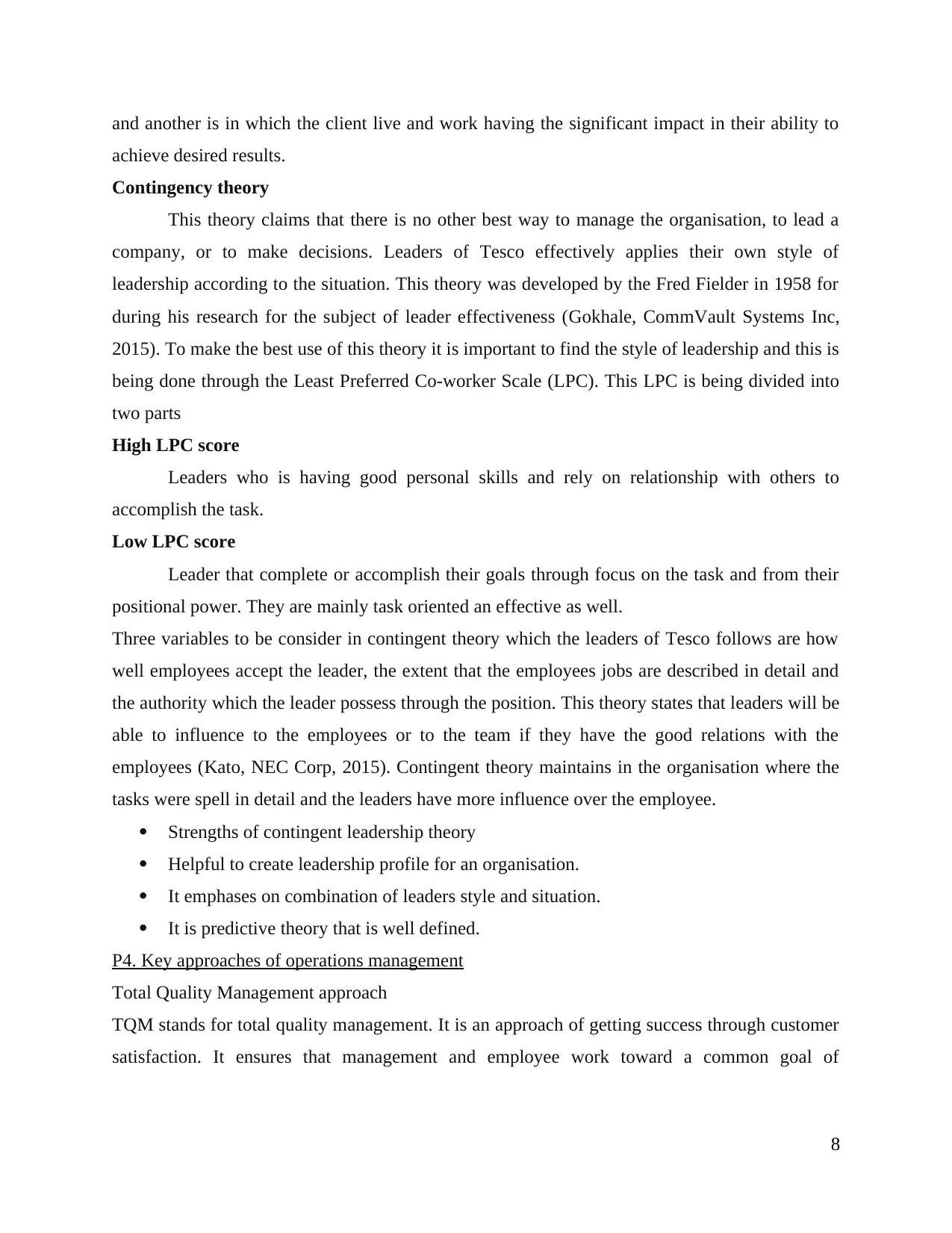
and another is in which the client live and work having the significant impact in their ability to
achieve desired results.
Contingency theory
This theory claims that there is no other best way to manage the organisation, to lead a
company, or to make decisions. Leaders of Tesco effectively applies their own style of
leadership according to the situation. This theory was developed by the Fred Fielder in 1958 for
during his research for the subject of leader effectiveness (Gokhale, CommVault Systems Inc,
2015). To make the best use of this theory it is important to find the style of leadership and this is
being done through the Least Preferred Co-worker Scale (LPC). This LPC is being divided into
two parts
High LPC score
Leaders who is having good personal skills and rely on relationship with others to
accomplish the task.
Low LPC score
Leader that complete or accomplish their goals through focus on the task and from their
positional power. They are mainly task oriented an effective as well.
Three variables to be consider in contingent theory which the leaders of Tesco follows are how
well employees accept the leader, the extent that the employees jobs are described in detail and
the authority which the leader possess through the position. This theory states that leaders will be
able to influence to the employees or to the team if they have the good relations with the
employees (Kato, NEC Corp, 2015). Contingent theory maintains in the organisation where the
tasks were spell in detail and the leaders have more influence over the employee.
Strengths of contingent leadership theory
Helpful to create leadership profile for an organisation.
It emphases on combination of leaders style and situation.
It is predictive theory that is well defined.
P4. Key approaches of operations management
Total Quality Management approach
TQM stands for total quality management. It is an approach of getting success through customer
satisfaction. It ensures that management and employee work toward a common goal of
8
achieve desired results.
Contingency theory
This theory claims that there is no other best way to manage the organisation, to lead a
company, or to make decisions. Leaders of Tesco effectively applies their own style of
leadership according to the situation. This theory was developed by the Fred Fielder in 1958 for
during his research for the subject of leader effectiveness (Gokhale, CommVault Systems Inc,
2015). To make the best use of this theory it is important to find the style of leadership and this is
being done through the Least Preferred Co-worker Scale (LPC). This LPC is being divided into
two parts
High LPC score
Leaders who is having good personal skills and rely on relationship with others to
accomplish the task.
Low LPC score
Leader that complete or accomplish their goals through focus on the task and from their
positional power. They are mainly task oriented an effective as well.
Three variables to be consider in contingent theory which the leaders of Tesco follows are how
well employees accept the leader, the extent that the employees jobs are described in detail and
the authority which the leader possess through the position. This theory states that leaders will be
able to influence to the employees or to the team if they have the good relations with the
employees (Kato, NEC Corp, 2015). Contingent theory maintains in the organisation where the
tasks were spell in detail and the leaders have more influence over the employee.
Strengths of contingent leadership theory
Helpful to create leadership profile for an organisation.
It emphases on combination of leaders style and situation.
It is predictive theory that is well defined.
P4. Key approaches of operations management
Total Quality Management approach
TQM stands for total quality management. It is an approach of getting success through customer
satisfaction. It ensures that management and employee work toward a common goal of
8

improving the quality of goods and services and enhance the production process (Haralson and
et.al., 2017). These are the principle of total quality management:
• Customer satisfaction: Customer are the end user of the product. They ensure the quality
of the product.
• Employee role: Employee empowerment, employee involvement and rewards help the
organisation to achieve the goal.
• Process centred: It involves the process of conversion of input (raw material) into output
(goods and services) which are delivered to the end user.
Role of leader and manager in TQM
TESCO may implement TQM in their organisation to maintain the quality of there products and
ensure that the process work smoothly. The manager work as a facilitator in the firm and regulate
the activities, assist employee, motivate the workers and assign resources to them. The role of
manager is:
• To train the employees
• Communicate the benefits of TQM to the management and workers
• Help in decision making
• Work as a role model
• Inspire employee to work in changing environment
Just In Time approach
Just in time approach used to reduce the inventory cost and increase the efficiency of the
production process. It provides the raw material directly from the suppliers when they needed. It
eliminates the overproduction waste, waiting time, warehouse cost, inventory waste and
transportation cost (Fernie and Sparks, 2018). Working capital are also less required under JIT
method because it ordered the stock only when it required. It also minimized rework,
maintenance and inspection cost.
Role of Manager and Leader in Just In Time approach
In TESCO, manager has to evaluate the production process and order the raw material. Its
Manager duty to forecast the demand of goods and services in the market and provide them to
the end user. Manager also has to evaluate the supply chain management system in the market
and regulate the distribution system (Kiehtreiber and et.al., 2015). TESCO can reduce the
9
et.al., 2017). These are the principle of total quality management:
• Customer satisfaction: Customer are the end user of the product. They ensure the quality
of the product.
• Employee role: Employee empowerment, employee involvement and rewards help the
organisation to achieve the goal.
• Process centred: It involves the process of conversion of input (raw material) into output
(goods and services) which are delivered to the end user.
Role of leader and manager in TQM
TESCO may implement TQM in their organisation to maintain the quality of there products and
ensure that the process work smoothly. The manager work as a facilitator in the firm and regulate
the activities, assist employee, motivate the workers and assign resources to them. The role of
manager is:
• To train the employees
• Communicate the benefits of TQM to the management and workers
• Help in decision making
• Work as a role model
• Inspire employee to work in changing environment
Just In Time approach
Just in time approach used to reduce the inventory cost and increase the efficiency of the
production process. It provides the raw material directly from the suppliers when they needed. It
eliminates the overproduction waste, waiting time, warehouse cost, inventory waste and
transportation cost (Fernie and Sparks, 2018). Working capital are also less required under JIT
method because it ordered the stock only when it required. It also minimized rework,
maintenance and inspection cost.
Role of Manager and Leader in Just In Time approach
In TESCO, manager has to evaluate the production process and order the raw material. Its
Manager duty to forecast the demand of goods and services in the market and provide them to
the end user. Manager also has to evaluate the supply chain management system in the market
and regulate the distribution system (Kiehtreiber and et.al., 2015). TESCO can reduce the
9
⊘ This is a preview!⊘
Do you want full access?
Subscribe today to unlock all pages.

Trusted by 1+ million students worldwide
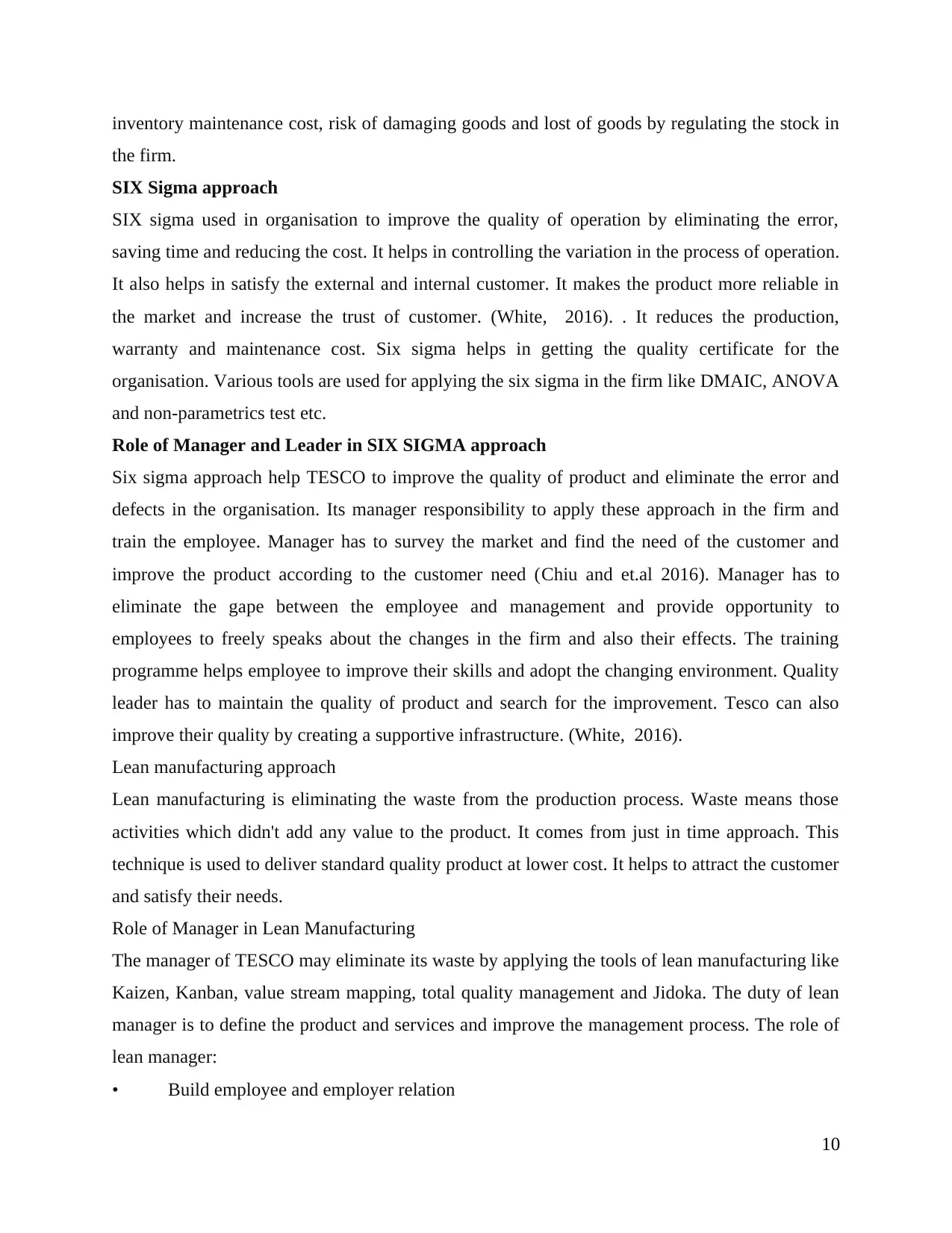
inventory maintenance cost, risk of damaging goods and lost of goods by regulating the stock in
the firm.
SIX Sigma approach
SIX sigma used in organisation to improve the quality of operation by eliminating the error,
saving time and reducing the cost. It helps in controlling the variation in the process of operation.
It also helps in satisfy the external and internal customer. It makes the product more reliable in
the market and increase the trust of customer. (White, 2016). . It reduces the production,
warranty and maintenance cost. Six sigma helps in getting the quality certificate for the
organisation. Various tools are used for applying the six sigma in the firm like DMAIC, ANOVA
and non-parametrics test etc.
Role of Manager and Leader in SIX SIGMA approach
Six sigma approach help TESCO to improve the quality of product and eliminate the error and
defects in the organisation. Its manager responsibility to apply these approach in the firm and
train the employee. Manager has to survey the market and find the need of the customer and
improve the product according to the customer need (Chiu and et.al 2016). Manager has to
eliminate the gape between the employee and management and provide opportunity to
employees to freely speaks about the changes in the firm and also their effects. The training
programme helps employee to improve their skills and adopt the changing environment. Quality
leader has to maintain the quality of product and search for the improvement. Tesco can also
improve their quality by creating a supportive infrastructure. (White, 2016).
Lean manufacturing approach
Lean manufacturing is eliminating the waste from the production process. Waste means those
activities which didn't add any value to the product. It comes from just in time approach. This
technique is used to deliver standard quality product at lower cost. It helps to attract the customer
and satisfy their needs.
Role of Manager in Lean Manufacturing
The manager of TESCO may eliminate its waste by applying the tools of lean manufacturing like
Kaizen, Kanban, value stream mapping, total quality management and Jidoka. The duty of lean
manager is to define the product and services and improve the management process. The role of
lean manager:
• Build employee and employer relation
10
the firm.
SIX Sigma approach
SIX sigma used in organisation to improve the quality of operation by eliminating the error,
saving time and reducing the cost. It helps in controlling the variation in the process of operation.
It also helps in satisfy the external and internal customer. It makes the product more reliable in
the market and increase the trust of customer. (White, 2016). . It reduces the production,
warranty and maintenance cost. Six sigma helps in getting the quality certificate for the
organisation. Various tools are used for applying the six sigma in the firm like DMAIC, ANOVA
and non-parametrics test etc.
Role of Manager and Leader in SIX SIGMA approach
Six sigma approach help TESCO to improve the quality of product and eliminate the error and
defects in the organisation. Its manager responsibility to apply these approach in the firm and
train the employee. Manager has to survey the market and find the need of the customer and
improve the product according to the customer need (Chiu and et.al 2016). Manager has to
eliminate the gape between the employee and management and provide opportunity to
employees to freely speaks about the changes in the firm and also their effects. The training
programme helps employee to improve their skills and adopt the changing environment. Quality
leader has to maintain the quality of product and search for the improvement. Tesco can also
improve their quality by creating a supportive infrastructure. (White, 2016).
Lean manufacturing approach
Lean manufacturing is eliminating the waste from the production process. Waste means those
activities which didn't add any value to the product. It comes from just in time approach. This
technique is used to deliver standard quality product at lower cost. It helps to attract the customer
and satisfy their needs.
Role of Manager in Lean Manufacturing
The manager of TESCO may eliminate its waste by applying the tools of lean manufacturing like
Kaizen, Kanban, value stream mapping, total quality management and Jidoka. The duty of lean
manager is to define the product and services and improve the management process. The role of
lean manager:
• Build employee and employer relation
10
Paraphrase This Document
Need a fresh take? Get an instant paraphrase of this document with our AI Paraphraser
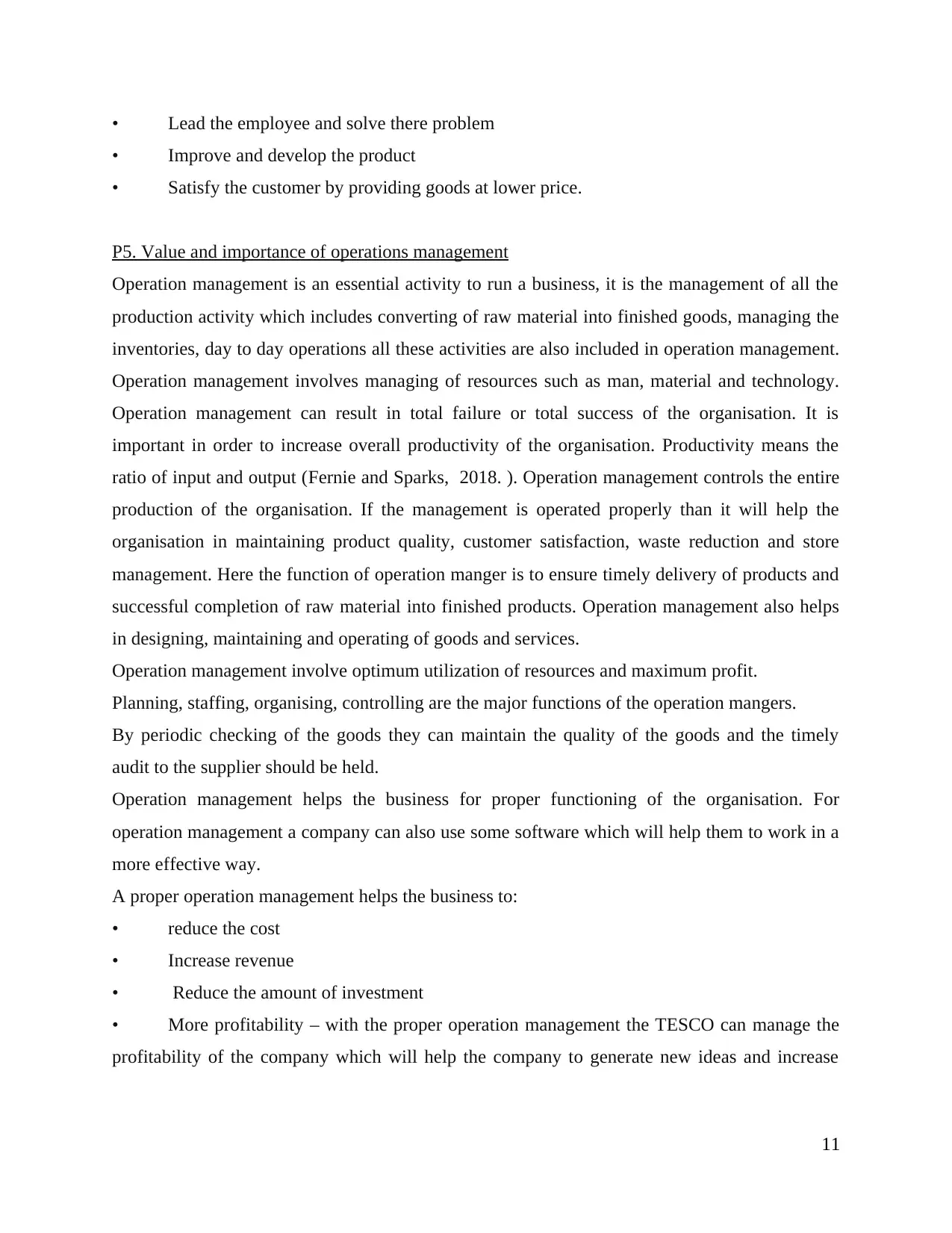
• Lead the employee and solve there problem
• Improve and develop the product
• Satisfy the customer by providing goods at lower price.
P5. Value and importance of operations management
Operation management is an essential activity to run a business, it is the management of all the
production activity which includes converting of raw material into finished goods, managing the
inventories, day to day operations all these activities are also included in operation management.
Operation management involves managing of resources such as man, material and technology.
Operation management can result in total failure or total success of the organisation. It is
important in order to increase overall productivity of the organisation. Productivity means the
ratio of input and output (Fernie and Sparks, 2018. ). Operation management controls the entire
production of the organisation. If the management is operated properly than it will help the
organisation in maintaining product quality, customer satisfaction, waste reduction and store
management. Here the function of operation manger is to ensure timely delivery of products and
successful completion of raw material into finished products. Operation management also helps
in designing, maintaining and operating of goods and services.
Operation management involve optimum utilization of resources and maximum profit.
Planning, staffing, organising, controlling are the major functions of the operation mangers.
By periodic checking of the goods they can maintain the quality of the goods and the timely
audit to the supplier should be held.
Operation management helps the business for proper functioning of the organisation. For
operation management a company can also use some software which will help them to work in a
more effective way.
A proper operation management helps the business to:
• reduce the cost
• Increase revenue
• Reduce the amount of investment
• More profitability – with the proper operation management the TESCO can manage the
profitability of the company which will help the company to generate new ideas and increase
11
• Improve and develop the product
• Satisfy the customer by providing goods at lower price.
P5. Value and importance of operations management
Operation management is an essential activity to run a business, it is the management of all the
production activity which includes converting of raw material into finished goods, managing the
inventories, day to day operations all these activities are also included in operation management.
Operation management involves managing of resources such as man, material and technology.
Operation management can result in total failure or total success of the organisation. It is
important in order to increase overall productivity of the organisation. Productivity means the
ratio of input and output (Fernie and Sparks, 2018. ). Operation management controls the entire
production of the organisation. If the management is operated properly than it will help the
organisation in maintaining product quality, customer satisfaction, waste reduction and store
management. Here the function of operation manger is to ensure timely delivery of products and
successful completion of raw material into finished products. Operation management also helps
in designing, maintaining and operating of goods and services.
Operation management involve optimum utilization of resources and maximum profit.
Planning, staffing, organising, controlling are the major functions of the operation mangers.
By periodic checking of the goods they can maintain the quality of the goods and the timely
audit to the supplier should be held.
Operation management helps the business for proper functioning of the organisation. For
operation management a company can also use some software which will help them to work in a
more effective way.
A proper operation management helps the business to:
• reduce the cost
• Increase revenue
• Reduce the amount of investment
• More profitability – with the proper operation management the TESCO can manage the
profitability of the company which will help the company to generate new ideas and increase
11
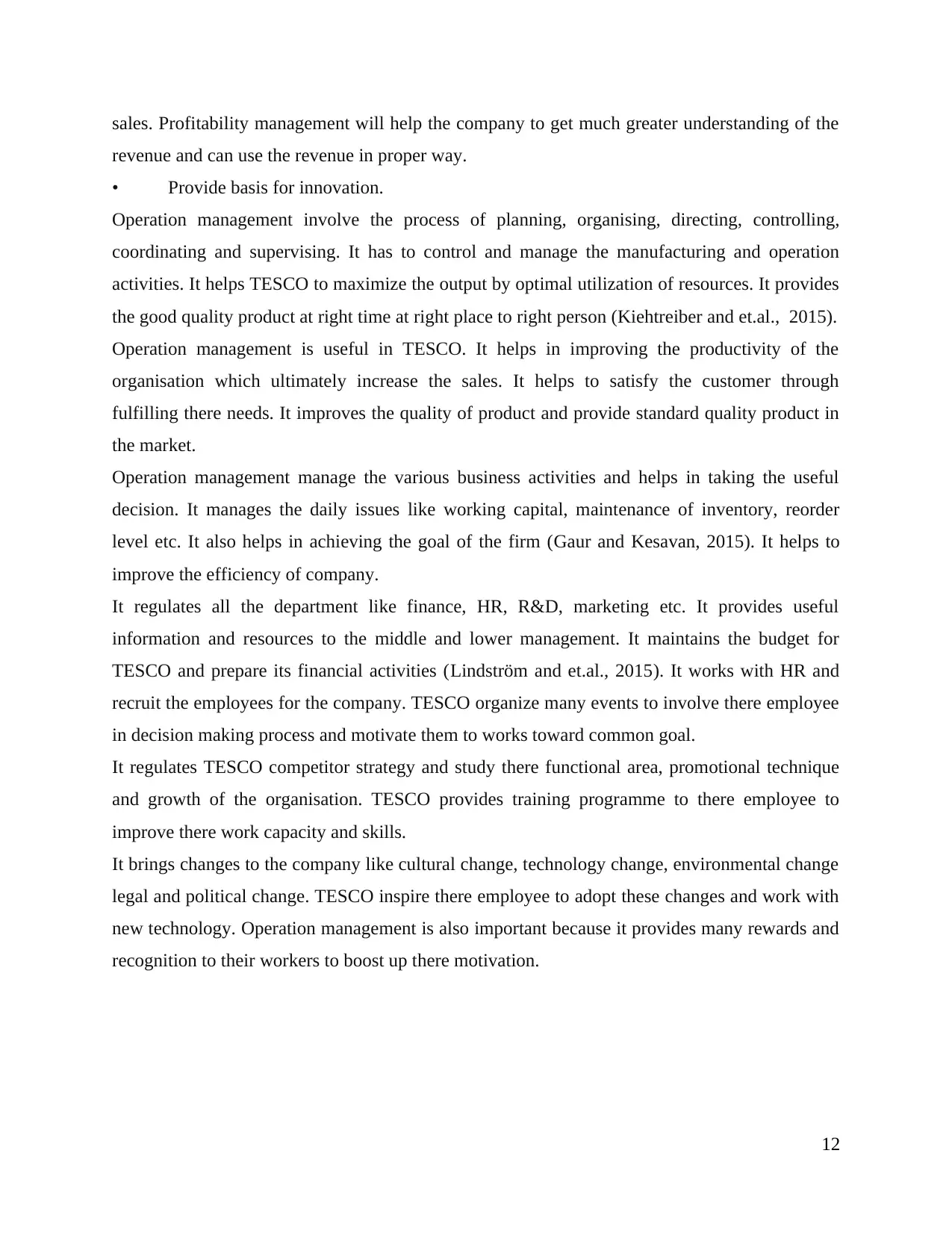
sales. Profitability management will help the company to get much greater understanding of the
revenue and can use the revenue in proper way.
• Provide basis for innovation.
Operation management involve the process of planning, organising, directing, controlling,
coordinating and supervising. It has to control and manage the manufacturing and operation
activities. It helps TESCO to maximize the output by optimal utilization of resources. It provides
the good quality product at right time at right place to right person (Kiehtreiber and et.al., 2015).
Operation management is useful in TESCO. It helps in improving the productivity of the
organisation which ultimately increase the sales. It helps to satisfy the customer through
fulfilling there needs. It improves the quality of product and provide standard quality product in
the market.
Operation management manage the various business activities and helps in taking the useful
decision. It manages the daily issues like working capital, maintenance of inventory, reorder
level etc. It also helps in achieving the goal of the firm (Gaur and Kesavan, 2015). It helps to
improve the efficiency of company.
It regulates all the department like finance, HR, R&D, marketing etc. It provides useful
information and resources to the middle and lower management. It maintains the budget for
TESCO and prepare its financial activities (Lindström and et.al., 2015). It works with HR and
recruit the employees for the company. TESCO organize many events to involve there employee
in decision making process and motivate them to works toward common goal.
It regulates TESCO competitor strategy and study there functional area, promotional technique
and growth of the organisation. TESCO provides training programme to there employee to
improve there work capacity and skills.
It brings changes to the company like cultural change, technology change, environmental change
legal and political change. TESCO inspire there employee to adopt these changes and work with
new technology. Operation management is also important because it provides many rewards and
recognition to their workers to boost up there motivation.
12
revenue and can use the revenue in proper way.
• Provide basis for innovation.
Operation management involve the process of planning, organising, directing, controlling,
coordinating and supervising. It has to control and manage the manufacturing and operation
activities. It helps TESCO to maximize the output by optimal utilization of resources. It provides
the good quality product at right time at right place to right person (Kiehtreiber and et.al., 2015).
Operation management is useful in TESCO. It helps in improving the productivity of the
organisation which ultimately increase the sales. It helps to satisfy the customer through
fulfilling there needs. It improves the quality of product and provide standard quality product in
the market.
Operation management manage the various business activities and helps in taking the useful
decision. It manages the daily issues like working capital, maintenance of inventory, reorder
level etc. It also helps in achieving the goal of the firm (Gaur and Kesavan, 2015). It helps to
improve the efficiency of company.
It regulates all the department like finance, HR, R&D, marketing etc. It provides useful
information and resources to the middle and lower management. It maintains the budget for
TESCO and prepare its financial activities (Lindström and et.al., 2015). It works with HR and
recruit the employees for the company. TESCO organize many events to involve there employee
in decision making process and motivate them to works toward common goal.
It regulates TESCO competitor strategy and study there functional area, promotional technique
and growth of the organisation. TESCO provides training programme to there employee to
improve there work capacity and skills.
It brings changes to the company like cultural change, technology change, environmental change
legal and political change. TESCO inspire there employee to adopt these changes and work with
new technology. Operation management is also important because it provides many rewards and
recognition to their workers to boost up there motivation.
12
⊘ This is a preview!⊘
Do you want full access?
Subscribe today to unlock all pages.

Trusted by 1+ million students worldwide
1 out of 19
Related Documents
Your All-in-One AI-Powered Toolkit for Academic Success.
+13062052269
info@desklib.com
Available 24*7 on WhatsApp / Email
![[object Object]](/_next/static/media/star-bottom.7253800d.svg)
Unlock your academic potential
Copyright © 2020–2025 A2Z Services. All Rights Reserved. Developed and managed by ZUCOL.





